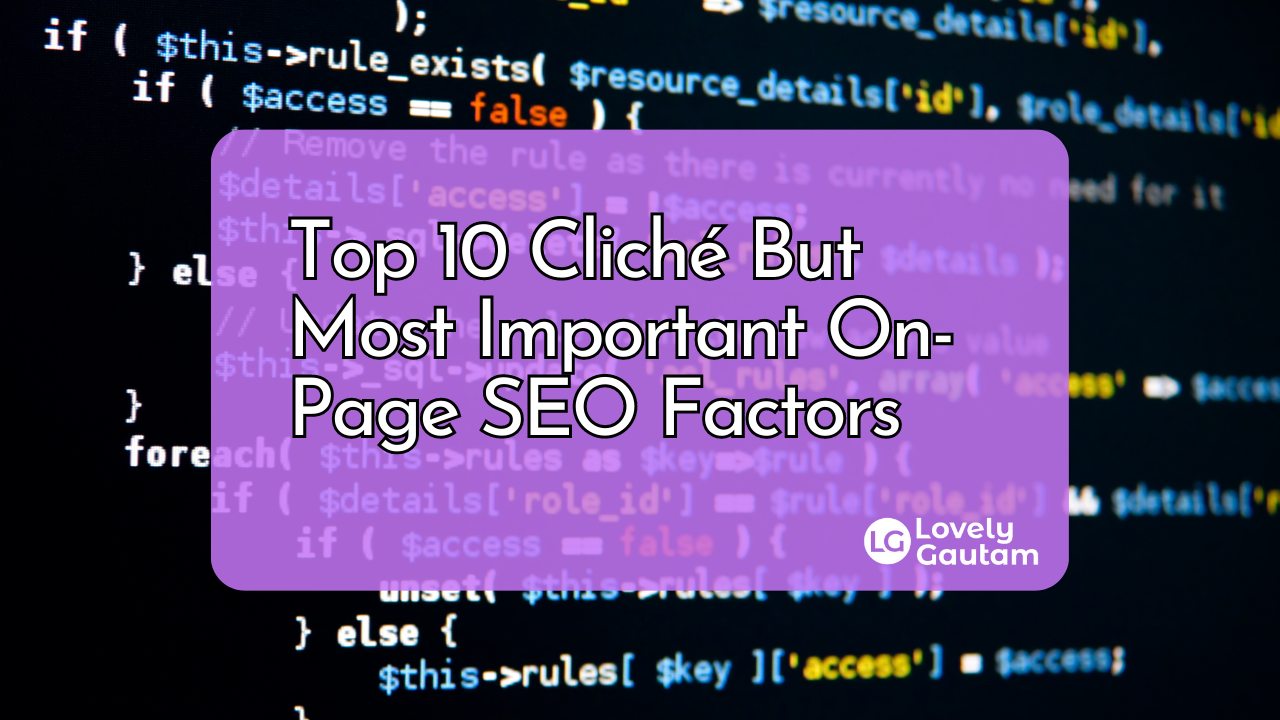
In the everlasting realm of search engine optimization (SEO), on-page factors play a vital role in determining the success of visibility and ranking of a website. Optimizing your website’s on-page elements is essential for improving its search engine performance and attracting organic traffic. In this blogpost, we will explore the 10 most important on-page optimization SEO factors that can significantly impact your website’s ranking and visibility.
When it comes to on-page SEO, there are several factors that search engines consider to identify the quality of a web page. These factors can directly influence how well your website ranks in search engine results and ultimately impact your online visibility. Let’s delve into the three most important on-page SEO factors that you should prioritize.
Headings and Title Tags

Headings and title tags play a crucial role in organizing your web page content and aiding search engines in comprehending the hierarchy of information. Utilizing heading tags (such as H1, H2, H3, etc.) appropriately enables you to structure your content effectively and emphasize significant sections. The H1 tag should incorporate the primary keyword or central focus of the page, while H2 and H3 tags can be employed for subheadings and additional categorization. Skillful implementation of headings not only enhances readability and improves the user experience but also signifies the relevance of your content to search engines.
Content Quality and Relevance
High-quality and relevant content is paramount for successful on-page SEO.
Search engines aim to deliver valuable and informative content that aligns with users’ search queries. It is essential to create well-written, engaging content that genuinely benefits your audience and offers them valuable insights. By focusing on delivering high-quality content, you can enhance your website’s visibility and attract organic traffic from search engines.
Integrate relevant keywords seamlessly into your content, ensuring a natural flow. However, be cautious about keyword stuffing, as it can negatively impact your search engine rankings.. Focus on maintaining a balanced and organic use of keywords to enhance your content’s effectiveness. By creating compelling content that addresses the needs of your target audience, you can increase user engagement, reduce bounce rates, and improve your website’s visibility.
Descriptions

Meta tags and descriptions provide concise summaries of your web page content and are displayed in search engine results. The title tag, displayed as the clickable headline, should be compelling, descriptive, and include the primary keyword for on-page SEO factors. The meta description, appearing below the title tag, provides a brief overview of the page’s content.
Your content should captivate, be pertinent, and persuasive, encouraging users to click and visit your website. Aim to create an enticing and compelling experience that compels them to take action. By optimizing your meta tags and descriptions, you can improve click-through rates and attract more organic traffic to your site.
URL Structure and Keyword Usage
https://www.tesla.com/
https://www.tesla.com/modelx
https://www.tesla.com/solarroof
A well-structured URL can contribute to better user experience and search engine visibility. Use descriptive and keyword-rich URLs that accurately reflect the content of your web page. Avoid lengthy URLs with unnecessary parameters or symbols. Instead, opt for clean and readable URLs that incorporate relevant keywords. By implementing this on-page seo approach, search engines gain a better understanding of your page’s subject matter, increasing the likelihood of higher rankings for your targeted keywords.
Image Optimization

Images can significantly enhance the visual appeal of your website, but they can also impact your SEO efforts. Improve image optimization by using descriptive file names and alt tags that incorporate relevant keywords. Compress the image files to reduce their size without compromising quality, as large file sizes can slow down your website’s loading speed. Additionally, implement responsive design techniques to ensure that your images adjust properly across different devices and screen sizes.
Internal Linking

Internal linking involves back linking to other pages within your website to enhance navigation and provide a seamless user experience. It helps search engines navigate and understand the structure of your site, as well as establishes the relevance and hierarchy of different pages.
Strategically incorporate internal links throughout your content, using descriptive anchor text that includes relevant keywords. This not only improves the user experience by providing additional information but also distributes link equity and boosts the visibility of important pages on your website.
User Experience and Site Speed

User experience is a vital factor in on-page SEO. Search engines prioritize websites that offer a seamless and user-friendly experience. Ensure that your website pages loads quickly, as slow-loading pages can result in increased bounce rates and diminished rankings on search engines.
It is crucial to optimize page speed for better UI and improved search engine visibility.. Optimize your website’s performance by compressing CSS and JavaScript files, leveraging browser caching, and minimizing server response time. Additionally, make your website easy to navigate with intuitive menus and clear calls to action, allowing users to find the information they need quickly and efficiently.
Mobile-Friendliness

With the increasing use of mobile devices for internet browsing, having a mobile-friendly website is imperative for on-page SEO. Make sure your website is responsive and capable of adjusting smoothly to various screen sizes.
A mobile-friendly website not only improves user experience but also satisfies the mobile-first indexing requirements of search engines. This implies that search engines will prioritize the mobile version of your webpages as the main source of content when indexing and ranking.
Social Media Integration

While not a direct on-page SEO factor, social media integration can indirectly influence your website’s visibility and traffic. The presence of social media signals, such as shares, likes, and comments, can demonstrate the popularity and significance of your content.
Including social media sharing buttons on your web pages encourages visitors to share your content, which can result in greater visibility and the possibility of gaining backlinks. This social proof can positively impact your website’s reputation and search engine rankings.
Clear and Readable Content

In addition to quality and relevance, it’s essential to create content that is clear and readable. Use concise sentences and paragraphs to convey your message effectively. Enhance the readability of your text by incorporating subheadings, bullet points, and numbered lists. This formatting style makes it easier for readers to scan through the content and grasp the key points effortlessly. Avoid using complex jargon or technical terms unless necessary, and strive to maintain a conversational tone throughout the article.
Conclusion
When it comes to on-page SEO, focusing on these three important factors can significantly improve your website’s visibility, user experience, and search engine rankings. By optimizing your headings and title tags, creating high-quality and relevant content, and paying attention to meta tags and descriptions, you can enhance your website’s on-page SEO performance.
Additionally, factors such as URL structure, image optimization, internal linking, user experience, mobile-friendliness, and social media integration all contribute to a comprehensive on-page SEO strategy that can drive organic traffic and boost your online presence.
FAQs
Q1: How long does it take to see results from on-page SEO optimization?
A1: The timeframe to see results from on-page SEO optimization can vary depending on various factors, such as the competitiveness of keywords, website authority, and the level of optimization. Generally, it takes time for search engines to crawl and index the updated pages. Patience is key, and it’s important to monitor your website’s performance over time.
Q2: Can I rank high in search engine results with on-page SEO alone?
A2: While on-page SEO is crucial for search engine rankings, it’s not the only factor. Off-page factors such as backlinks and domain authority also play significant roles. A comprehensive SEO strategy combines both on-page and off-page optimization techniques to achieve optimal results.
Q3: How often should I update my meta tags and descriptions?
A3: It’s advisable to review and update your meta tags and descriptions periodically, especially for important pages or when targeting specific keywords. Keeping them relevant, engaging, and aligned with the content can help improve click-through rates and attract more organic traffic
